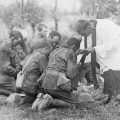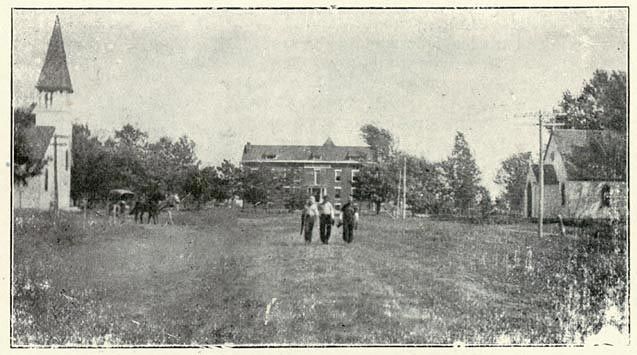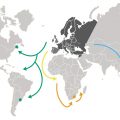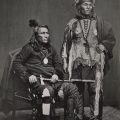A frontier is a transition zone between two regions, between two areas with different cultures. For the European invaders in North America, the frontier represented the transition between civilization—defined by European languages, governments, and religion—and barbarism—defined by the pagan and incomprehensible Native American cultures. For the English colonists in North America, the frontier was a broad line running north-south and for the English the frontier was always to the west. In New Spain, however, the frontier was to the north. For the colonial Spanish, one of the frontier zones was the area that is today known as Texas.
For the Spanish, the northern frontier of Texas was an area that had to be civilized through the conversion of Native peoples to Catholicism either by persuasion or by force of arms. From 1673 until 1728 Catholic missionaries worked in Texas, establishing missions and seeking converts.
In 1673, in response to what was viewed as a request for Christian missionaries by the Coahuiltecan, the Franciscans sent Fray San Buenaventura and a force of ten soldiers north from Nuestra Señora de Guadalupe in Coahuila north across the Rio Grande. When the expedition returned, Fray San Buenaventura recommended that the Spanish establish three missions among the Coahuiltecan and that each mission be protected by a presidio (fort) of not less than 70 soldiers.
In 1675, Spanish explorers, including a group of Franciscans, traveled northward from Eagle Pass to present-day Edwards County. They encountered three tribes and noted that smallpox had already decimated tribal numbers. Some of the tribes were hunting buffalo and making jerky.
In 1683, Jumano chief Juan Sabeata led a multi-tribal delegation to El Paso to speak with Spanish state and church officials. Sabeata was appointed to the position of gobernador by the Spanish. Juan Sabeata told the Spanish about the thirty-some tribes to the east, including the “Great Kingdom of the Texas” (the Caddo).
In response to the request by Jumano leader Juan Sabeata the Spanish sent out an expedition to explore the Nueces River country, to learn about the Jumano and other Indian nations in the territory, and to bring back specimens of the pearls which were reported to be there. The Franciscan missionaries Nicolás López and Juan Zavaleta were in charge of the religious aspects of the expedition. The expedition turned back after reaching the Colorado River of Texas and having been attacked several times by the Apache.
In 1690, Fray Francisco Casañas de Jesus María founded a mission on the banks of the Neches River. The mission was named Santísimo Nombre de María and was intended to convert the Hasinai (Caddo).
Three years later, the Spanish missions and presidios in east Texas were abandoned because of lack of cooperation among the Caddo tribes in the area. One Hasinai medicine man convinced the people that baptism waters could be fatal. The Spanish priests found that the Caddo refused to believe in one god, but insisted that there were two: one who gave clothing, knives, hatchets, and other things to the Spanish; and one who gave corn, beans, acorns, nuts, and rain to the Indians.
At San Francisco de los Tejas the Spanish buried heavy objects, such as canons and bells, and then burned the mission. For several days, the Caddo followed the retreating Spanish at a distance to make sure they were really leaving. Four soldiers, however, deserted the Spanish to join the Caddo. Back at the mission, the soldiers showed the Indians where the heavier objects were buried.
In 1715, the Spanish decided to re-occupy east Texas and established four missions among the Indians.
The following year, a Spanish missionary party of 75 people, including six Querétan missionaries, reached the site of the abandoned Mission of San Francisco de los Texas. Four leagues inland from this site they established the Mission of San Francisco de los Neches. This mission was intended to serve the Neches, Nabedache, Nacogdoches, and Nacono.
Eight or nine leagues northeast of the new mission, they established another mission for the Hainai which was called the Mission of Nuestra Señora de la Purisima Concepción.
A third mission, Nuestra Señora de Guadalupe, was established for the Nacogdoche and Nacao. A fourth mission, San José de los Nazones, was established for the Nasoni and Nadaco.
In 1718, the Franciscans moved their mission from Eagle Pass to San Antonio where it became known as San Antonio de Valero.
In 1722, the Spanish established a fort, La Bahía, and the mission of Espíritu Santo de Zuñiga in Karankawa territory.
Four years later, the Spanish moved the Franciscan mission of Espíritu Santo de Zuñiga to the lower San Antonio River in Aranama territory.
In 1728, the Spanish sent General Pedro de Rivera to inspect the Indian missions. He reported: “there was not a single Indian at San Miguel de los Adaes; at Nuestra Señora de Guadalupe de Nocagdoches, although there were many Indians, industrious and well-disposed, they were all still heathens; at three missions, Nuestra Señora de la Concepción, San Francisco de los Neches, and San José de los Nazones, there were no Indians at all, with little hope of ever getting any.” In other words, the Spanish missionary efforts to convert the Indians accomplished very little.




Leave a Reply